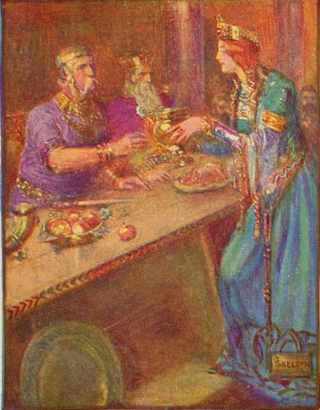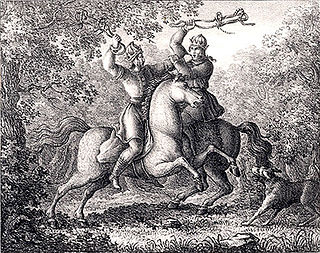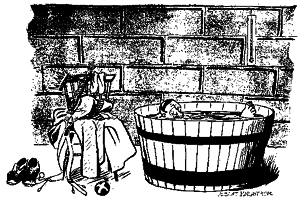
Ragnar Lodbrok, according to legends, was a Viking hero and a Swedish and Danish king.

Hrólfr Kraki, Hroðulf, Rolfo, Roluo, Rolf Krage was a semi-legendary Danish king who appears in both Anglo-Saxon and Scandinavian tradition.

Hrothgar was a semi-legendary Danish king living around the early sixth century AD.
Halfdan the Old was an ancient, legendary king from whom descended many of the most notable lineages of legend. A second Halfdan the Old is the purported great-grandfather of Ragnvald Eysteinsson.
Fróði is the name of a number of legendary Danish kings in various texts including Beowulf, Snorri Sturluson's Prose Edda and his Ynglinga saga, Saxo Grammaticus' Gesta Danorum, and the Grottasǫngr. A Danish king by this name also appears as a minor character in the Middle High German epic Rabenschlacht. The name is possibly an eponym for the god Freyr.

Yrsa, Yrse, Yrs or Urse was a tragic heroine of early Scandinavian legend.
Various gods and men appear as sons of Odin in Old Norse and Old English texts.

Harald Wartooth or Harold Hiltertooth was a semi-legendary king of Denmark who is mentioned in several traditional sources. He is held to have (indirectly) succeeded his father as king of Zealand and to have expanded his realm. According to different sources, he may have ruled over Jutland, part of Sweden and the historical northern German province of Wendland. He is said to have been finally defeated and killed at the legendary Battle of Bråvalla.

Alaric and Eric, according to legend, were two kings of Sweden.

Fjölnir is a legendary king in Norse mythology said to have been the son of Freyr (Frey) and his consort Gerðr (Gertha). The name appears in a variety of forms, including Fiolnir, Fjölner, Fjolner, and Fjolne. He was claimed as the progenitor of the Swedish Yngling dynasty, reigning from Gamla Uppsala. According to the Grottasöngr, Fjölnir lived from the 1st century BC to the early 1st century AD.
The Scyldings or Skjǫldungs, both meaning "descendants of Scyld/Skjǫldr", were, according to legends, a clan or dynasty of Danish kings, that in its time conquered and ruled Denmark and Sweden together with part of England, Ireland and North Germany. The name is explained in many texts, such as Friedrich Christoph Dahlmann's 'Research on the Field of History', by the descent of this family from an eponymous king Scyld, but the title is sometimes applied to rulers who purportedly reigned before him, and the supposed king may be an invention to explain the name. There was once a Norse saga on the dynasty, the Skjöldunga saga, but it survives only in a Latin summary by Arngrímur Jónsson.

Halfdan was a late 5th and early 6th century legendary Danish king of the Scylding (Skjöldung) lineage, the son of king named Fróði in many accounts, noted mainly as the father to the two kings who succeeded him in the rule of Denmark, kings named Hroðgar and Halga in the Old English poem Beowulf and named Hróar and Helgi in Old Norse accounts.

Hjalmar and Ingeborg were a legendary Swedish duo. The male protagonist Hjalmar and his duel for Ingeborg figures in the Hervarar saga and in Orvar-Odd's saga, as well as in Gesta Danorum, Lay of Hyndla and a number of Faroese ballads. Hjalmar never lost a battle until meeting a berserker wielding the cursed sword Tyrfing.

Svafrlami was in the H and U version of the Hervarar saga the son of Sigrlami, who was the son of Odin. In the R version, Svafrlami is called Sigrlami and his parentage is not given. Svafrlami was the king of Gardariki and the first owner of the magic sword Tyrfing.

Arngrim was a berserker, who features in Hervarar saga, Gesta Danorum, Lay of Hyndla, a number of Faroese ballads and Orvar-Odd's saga in Norse mythology.
Angantyr was the name of three male characters from the same line in Norse mythology, and who appear in Hervarar saga, Gesta Danorum, and Faroese ballads.
The Tyrfing Cycle is a collection of Norse legends, unified by the shared element of the magic sword Tyrfing. Two of the legends are found in the Poetic Edda, and the Hervarar saga can be seen as a compilation of these legends.
Glæsisvellir was a location in Jotunheim in Norse mythology. It is mentioned in sources such as Bósa saga ok Herrauds and Hervarar saga.
Ingeld or Ingjaldr was a legendary warrior who appears in early English and Norse legends. Ingeld was so well known that, in 797, Alcuin wrote a letter to Bishop Higbald of Lindisfarne questioning the monks' interest in heroic legends with: 'Quid enim Hinieldus cum Christo?' - What has Ingeld to do with Christ?

The Haddingjar refers on the one hand to Germanic heroic legends about two brothers by this name, and on the other hand to possibly related legends based on the Hasdingi, the royal dynasty of the Vandals. The accounts vary greatly.











